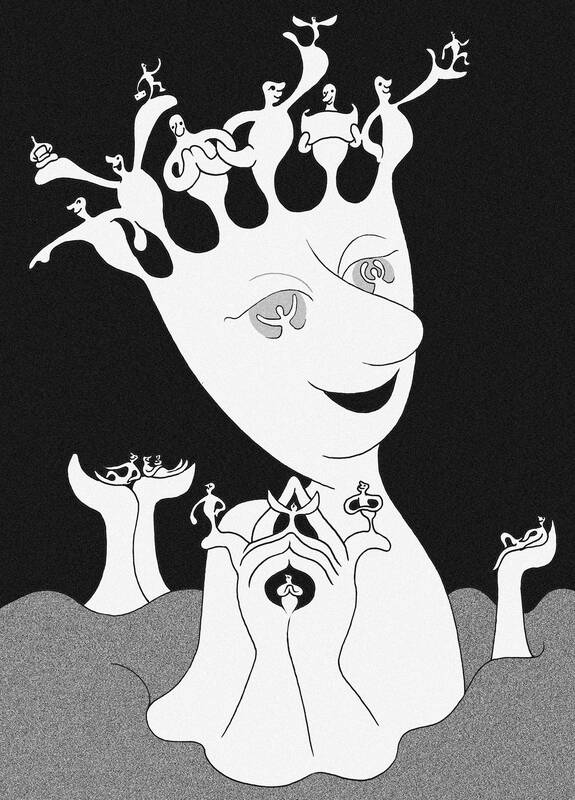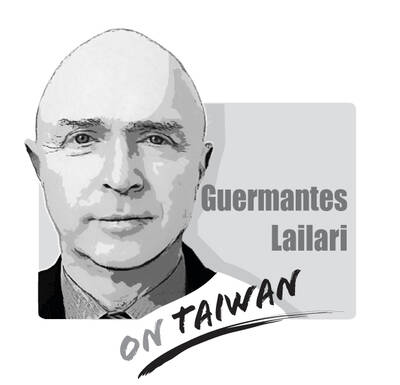I am all for life and liberty, but the pursuit of happiness? In penning his famous line in 1776, Thomas Jefferson might have been spot on about unalienable rights. As a life coach — which, admittedly, he did not claim to be — he and the entire Western Enlightenment caused lasting and unquantifiable damage.
During the festive and allegedly soulful season, I want to take some pressure off of you. Happiness should not be your goal, nor is it the point of life. Dwelling on it would only make you and others miserable. So do not worry about it.
The Western tradition was not always fixated on happiness. Aristotle, for one, set off in a more mature direction, by contemplating the “good life” more broadly and the role in it of eudaimonia. Regularly mistranslated as “happiness,” the word means “good spirit.”

Illustration: Mountain People
What Aristotle had in mind had nothing to do with smiley faces, and lots to do with what we would call flourishing. Basically, he viewed the good life as fulfilling your purpose, whatever that might be. If you are a knife, you cut. If you are Aristotle, you think. If you are I, you write and parent.
Another way of thinking about purpose might be duty. Aeneas, as Virgil described the Trojan hero, was rarely happy and often wretched. He was “pius” — meaning dutiful; the connotation “pious” came much later — and therefore lived well.
There is absolutely no need to make this notion either complicated or epic. Ralph Waldo Emerson brought Aristotle right down to earth: “The purpose of life is not to be happy. It is to be useful, to be honorable, to be compassionate, to have it make some difference.”
Of course, people who strive to live an Aristotelian life also pause occasionally to ponder where they are on their paths, just as seasoned travelers like to look back on their peregrinations. Then, for fleeting moments, they might feel an uplifting sensation that maybe all of this was, if not always fun, at least worthwhile. Go ahead and call that happiness, but recognize that it is retroactive, and would be gone again in a jiffy.
That is because these sporadic warm and fuzzy, or bright and bubbly, feelings usually evaporate as soon as people turn back to the present moment — the famous “now” of New Age lore. In that here and now, most of us cannot help but notice that life frequently just sucks.
For many people, life offers up a diet of pain, poverty, disease or hunger. Even when the menu features ease, wealth, health and cornucopia, people are still stuck with their own minds. Oh how the human psyche knows to torture. Its tricks range from anxiety to depression, anger, envy and all the rest.
The Athenian philosophers coming just after Aristotle understood this and therefore tried to refine notions about the good life. The results were Stoicism, Epicureanism, Skepticism and Cynicism — in their original, not their modern, senses, mind you. The Hellenistic thinkers, too, were not really aiming at happiness as such. Their goal was instead equanimity.
The world champions of thinking about the mind and equanimity were the Buddhists. The first of their four noble truths states that life is duhkha. This is usually translated as “suffering,” but means something closer to unease or discomfort. Yoga scholar T.K.V. Desikachar said that the etymology ultimately comes from the Sanskrit for “dark chamber.”
Basically, Buddhism recognizes that our natural state resembles being in a dark space, something like the opposite of happiness. The blame for that, again, belongs to the mind. Even if we are momentarily happy, for example, we would be unhappy as soon as that high is gone. Then we would forever crave another hit of happiness, like junkies needing their next fix.
The rest of Buddhism basically elaborates how — sort of, maybe, possibly — we can get ourselves “at ease” again. That involves observing the mind doing its stuff — by watching, but not judging, our thoughts. One thing meditators eventually notice is that bad emotions enter the mind, but also leave it again just as easily. So Buddhists practice politely seeing their inner nasties to the door and letting them go.
If all goes well, a person can eventually climb out of the dark chamber into a permanently lit place. That is rare, and the Sanskrit words for that experience do not exactly translate to happiness either. Instead they have meanings like liberation, release, emptiness or even “being blown out” (nirvana) like an extinguished candle. Enlightenment, in short, is quite a different idea in East and West. As an unalienable Jeffersonian right, the pursuit of being blown out does not cut it.
Having forgotten the legacy of the ancient Greeks and at best dabbled in Eastern thought, we in the West therefore went in a different direction. Sometimes we equate happiness with the bouncy optimism of Pollyanna, the title character in an American novel from 1913. More generally, it implies cheer and joy no matter what is going on. As that most annoying of songs puts it: “Don’t Worry, Be Happy.”
The psychology behind such Hallmark-card happiness falls somewhere between denial, escapism and self-deception. At one extreme, putting on a happy face when a situation objectively leaves much to be desired might make you stop or delay planning, saving, pursuing an education, sobering up or getting fit, thereby preprogramming future misery.
The modern happiness cult has other pernicious side effects. It leads to what some authors call a “happycracy” or “toxic positivity.” That is when the onus of not just pursuing, but actually catching up with, happiness falls on the individual person. If you are not happy, you must be doing something wrong. It is your fault.
That is a lot of pressure, and causes a lot of guilt — moving you even further away from happiness. Often, it is also downright, if inadvertently, cruel. The author Whitney Goodman, a psychotherapist, lists some particularly common and inappropriate positivity reflexes when we encounter grief: “You’ll be fine”; “just smile”; “you have so much to be grateful for”; “time heals all wounds”; “be grateful for what you learned”; “it could be worse.”
Spouting cliches such as these borders on sadistic if you are with somebody who just lost a job, got divorced, had a cancer diagnosis, suffered a miscarriage, got bombed out of Mariupol — or indeed somebody who simply feels lonely and down.
The better response to somebody who is unhappy —in the mirror or across the table — is to validate the pain, making it legitimate.
We should not overshoot in the other direction either, by dwelling on the bad that might or might not be yet to come. Unsurprisingly, our foes are once again our own minds. The problem is that in imagining future outcomes, human cognition has evolved a “negativity bias.” For purposes of survival in the ancestral savannas, it was better to assume the worst, whereas natural selection never cared a whit about anybody’s happiness.
That heritage makes us prone to what psychologists call “catastrophizing.” It is the recurring temptation, especially late at night or when we cannot sleep, to worry about the worst that could happen, rather than picturing more likely scenarios. This can lead to unwarranted and excessive anxiety.
Here is the advice I would try to follow, and not just during the holidays. First, ignore silly “happiness indices” and other claptrap. Second, strange as it sounds, do not feel bad if you are not happy. Third, remember that, like Aeneas, you have more important things to do in this world, so stay focused on those. Fourth, keep watching your own mind, lest it gallop off too wildly in the wrong directions.
I admit the possibility of one other secret weapon: a macabre sense of humor. “Much will be gained,” as Sigmund Freud allegedly said, “if we succeed in transforming your hysterical misery into ordinary unhappiness.” On that note, happy holidays.
Andreas Kluth is a Bloomberg Opinion columnist covering European politics. A former editor-in-chief of Handelsblatt Global and a writer for The Economist, he is author of Hannibal and Me. This column does not necessarily reflect the opinion of the editorial board or Bloomberg LP and its owners.

“History does not repeat itself, but it rhymes” (attributed to Mark Twain). The USSR was the international bully during the Cold War as it sought to make the world safe for Soviet-style Communism. China is now the global bully as it applies economic power and invests in Mao’s (毛澤東) magic weapons (the People’s Liberation Army [PLA], the United Front Work Department, and the Chinese Communist Party [CCP]) to achieve world domination. Freedom-loving countries must respond to the People’s Republic of China (PRC), especially in the Indo-Pacific (IP), as resolutely as they did against the USSR. In 1954, the US and its allies
A response to my article (“Invite ‘will-bes,’ not has-beens,” Aug. 12, page 8) mischaracterizes my arguments, as well as a speech by former British prime minister Boris Johnson at the Ketagalan Forum in Taipei early last month. Tseng Yueh-ying (曾月英) in the response (“A misreading of Johnson’s speech,” Aug. 24, page 8) does not dispute that Johnson referred repeatedly to Taiwan as “a segment of the Chinese population,” but asserts that the phrase challenged Beijing by questioning whether parts of “the Chinese population” could be “differently Chinese.” This is essentially a confirmation of Beijing’s “one country, two systems” formulation, which says that
Mainland Affairs Council Deputy Minister Shen You-chung (沈有忠) on Thursday last week urged democratic nations to boycott China’s military parade on Wednesday next week. The parade, a grand display of Beijing’s military hardware, is meant to commemorate the 80th anniversary of Japan’s surrender in World War II. While China has invited world leaders to attend, many have declined. A Kyodo News report on Sunday said that Japan has asked European and Asian leaders who have yet to respond to the invitation to refrain from attending. Tokyo is seeking to prevent Beijing from spreading its distorted interpretation of wartime history, the report
Indian Prime Minister Narendra Modi arrived in China yesterday, where he is to attend a summit of the Shanghai Cooperation Organization (SCO) with Chinese President Xi Jinping (習近平) and Russian President Vladimir Putin today. As this coincides with the 50 percent US tariff levied on Indian products, some Western news media have suggested that Modi is moving away from the US, and into the arms of China and Russia. Taiwan-Asia Exchange Foundation fellow Sana Hashmi in a Taipei Times article published yesterday titled “Myths around Modi’s China visit” said that those analyses have misrepresented India’s strategic calculations, and attempted to view